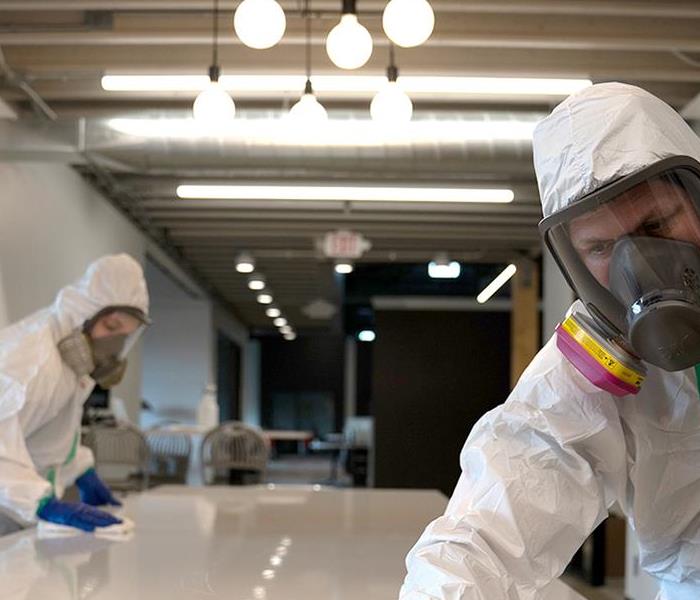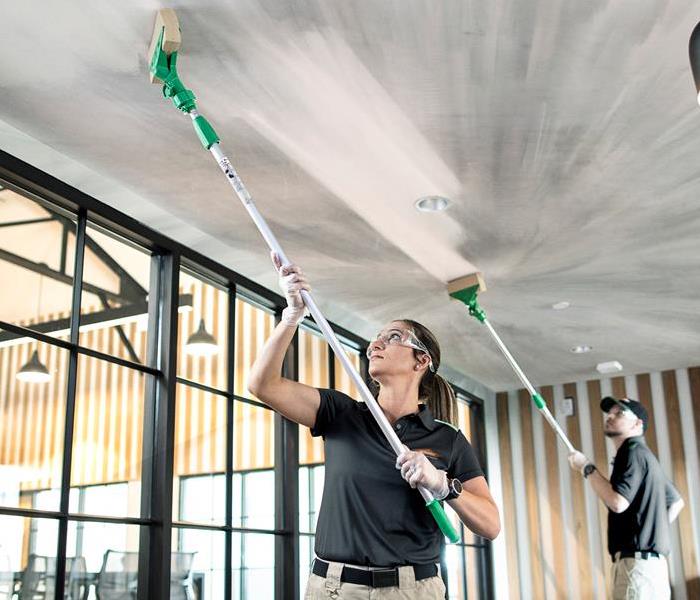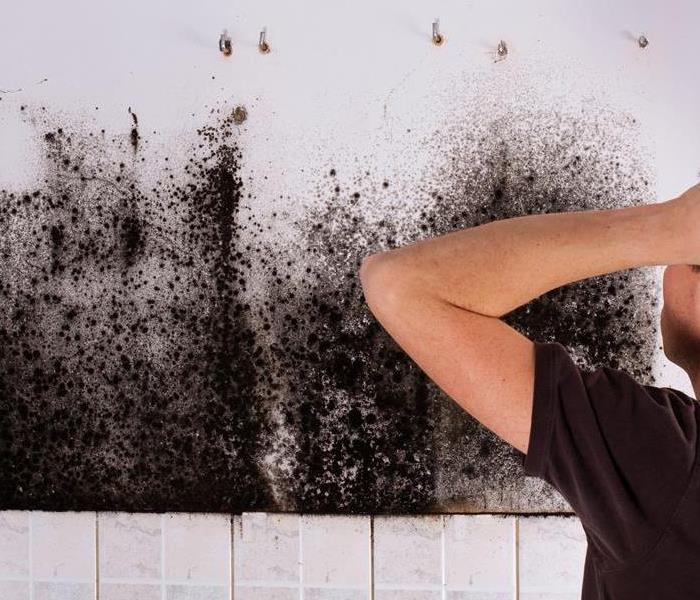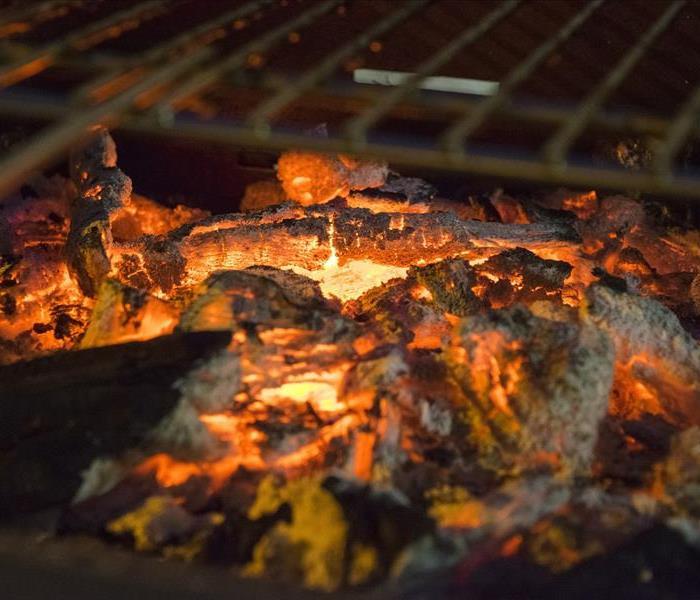Recent Posts
What is Water Mitigation?
6/17/2024 (Permalink)
If you clicked on this blog, it is likely because you are seeking water mitigation services but need a better understanding of what it exactly is? Water mitigation is the process of reducing or preventing the damage caused by water after a leak, burst pipe, or flood.
The primary goal of water mitigation is to minimize the impact of water damage and prevent secondary issues such as mold growth. SERVPRO® specializes in water mitigation and uses advanced equipment to clean up water from your home or business.
SERVPRO follows significant steps for water mitigation. After we arrive and perform the initial assessment, our technicians:
- Remove Water and Dry It Out – using wet/dry vacuums, dehumidifiers, industrial fans, and other tools; we begin extracting water and increasing airflow to achieve optimum drying conditions.
- Thoroughly Inspect Damage – We look at any areas impacted by water, determining what can be restored and what must be replaced. This may involve inspection of flooring, wall cavities, belongings, electrical outlets, and more.
- Disinfection – After your home is free of water and drying wraps up, we thoroughly clean and disinfect all surfaces affected by water. Our Green Fleet comes stocked with a full selection of EPA-registered cleaning agents.
No stone must get left unturned when it comes to water mitigation, regardless of the event that caused the emergency. We feature highly-trained and certified technicians that know how to adapt to each situation to ensure the best results.
Our 24-hour emergency restoration services are here whenever you need them, which is the perfect way to restore your interior to pre preloss condition “Like it never even happened.”
What to do if you have mold and how to fix it
6/17/2024 (Permalink)
There are many hazards that a small business owner or landlord has to take into account when maintaining their buildings and places of work. One of these hazards is mold and the smelly mycotoxin that always accompanies it. When allowed to go unchecked, this hazard can potentially ruin the hard work that has gone into a building or grind the business conducted within to a halt. To help prevent this, here are a few steps for renters and maintenance workers on how to recognize and fix mold growth.
1. Use Your Eyes
Mold can easily be mistaken for dirt or dust if not thoroughly inspected. Depending on what fungus present, the mold could take on a variety of different shades and textures. However, mold may not have a visual presence.
2. Use Your Nose
Spores often incubate where small hidden leaks show up or where condensation builds as a result of a possibly broken air condition unit or something similar. When this happens, investigators can rely on their noses. Mold growth is often revealed by a variation of a musty odor.
However, it's important to take note of any new smells. This is due to the scent of mold changing based on the spore count and where it is in its life cycle. After all, the smell is formed by the mycotoxin released by mold eating and multiplying.
3. Fix the Problem
Once the mold has been found, whether it’s out in the open or recently excavated, it’s important to immediately focus on mold remediation. This is because mold spreads quickly, often manifesting within 48–72 hours. If it looks like the mold is relatively contained and has only covered a small surface area, it is possible to get it cleaned up. In this case, cleaners should use the proper equipment and maintain safety standards during the process.
When maintaining a building, it’s good to be perceptive. If the mold has spread, remember that it’s important to call in a professional cleaning service. Safety should always be a priority when dealing with mold and its mycotoxin.
The 3 Signs of Mold
5/14/2024 (Permalink)
Mold is a type of fungus that develops from tiny spores that float around in the air, both indoors and outdoors. Mold is often found in humid or moist places, and if allowed to grow unchecked, it can present issues for a building. With that in mind, we offer this quick list to help you tell when mold is growing in your building:
1) Musty Odor
Even if you cannot see mold, it can be in your home or business. A very common indicator of the fungus is its smell. When mold grows in an area of your building, you will notice a pungent and musty smell. Take action immediately when you notice the odor. Mold overgrowth can cost you a great deal of money and even your health. You may not be aware of the full extent of the problem until professionals check in between walls and under floors.
2) The Appearance of Mold
Mold may look like cotton, granules, or leather. It can appear in various colors like white, green, gray, black, brown, or yellow. Unfortunately, many people ignore small mold and mistake it for soot or ordinary dirt. Take immediate action when you see tiny discolored and fuzzy growth on furnishings or the surface of building materials.
3) Water Leaks
If you notice water leaks from ceiling pipes, water stains, or standing water, mold might become an issue. Water leaks cause moisture, and that provides an excellent growing place for mold. Check for discoloration or watermarks on carpets, walls, and other materials for hidden mold.
Any business or home can face a fungus fiasco. If you suspect that you have a mold problem, SERVPRO® can inspect the property. Mold remediation is one of our specialties and we can eliminate the issue safely. We also invest in state-of-the-art equipment and continuous training that ensures your home or business is quickly and efficiently restored.
Give us a call today!
What Cause Home Fires? Unclean Grills
5/8/2024 (Permalink)
Nothing says summer in Nashville, TN like the smell of your favorite foods on the grill. When the temperatures climb, it may feel easier to take dinner prep outdoors rather than sweat over a hot stove. However, it's important to clean your grill every time you use it. Not only does this prolong the life of the appliance, but it protects your home from fires as well.
In a survey between 2014-2018, over 10,600 home fires were linked to grills and barbecues. A buildup of oil and grease makes your grill more susceptible to putting up large flames that can catch onto porches, roofs, and dry grass. Proper grill maintenance is essential for keeping your favorite summer activity safe.
- Clean the Grates
Proper grill cleaning after every meal makes maintenance much easier. For either a gas or charcoal grill, scrub the grates while they're still hot and before the food particles stick too badly.
Some people like wire brushes, though balled-up aluminum foil also works and won't leave little bristles behind.
- Check for Grease or Ashes
Avoiding grease fires is a top priority with gas grills. Before you turn on the grill, check the grease tray. If it gets overfilled, you'll be cleaning grease spots off your patio.
Similarly, always dispose of all completely cooled ashes from your charcoal barbecue.
- Deep Clean Annually
When the grilling season ends, deep grill cleaning saves your grill and prevents problems next season. Kicking off the season the next year with a fire due to an improperly maintained grill can put a major damper on your next barbecue. - Know Grease Fire Safety
Educate yourself on how to extinguish a fire in your grill. Never use water, as water can actually make a grease fire worse. Closing the lid is a good first step because it stops oxygen flow to the flames.
If you do have a home fire, a local fire restoration company can help with repairs.
Enjoy the grilling season to the fullest by practicing good grill cleaning habits to protect your home and your dinner.
Innovative Technologies Powering Smoke Odor Removal in Fire Damage Restoration
6/7/2023 (Permalink)
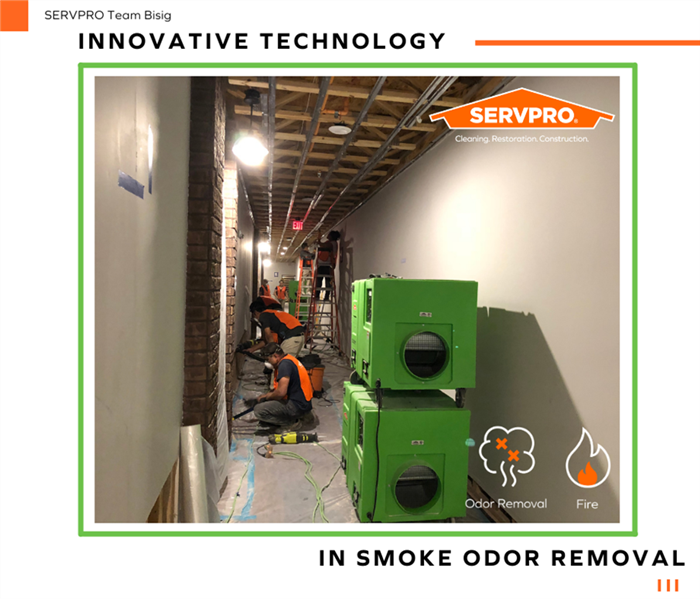 SERVPRO of Southeast Nashville utilizes the latest technology available to eliminate all traces of fire and smoke.
SERVPRO of Southeast Nashville utilizes the latest technology available to eliminate all traces of fire and smoke.
Navigating the Aftermath of Fire Damage
At SERVPRO of Southeast Nashville, we understand the challenges homeowners face in the aftermath of a fire. Beyond the visible destruction, smoke odors linger, infiltrating every nook and corner of your property. Our fire damage restoration services are designed to not only address the visible damage but also to restore your home's ambiance by effectively and permanently eliminating smoke odors. In this article, we'll dive into the innovative technologies powering smoke odor removal, giving you insights into our process and the cutting-edge solutions we employ right here in Nashville, Percy Priest, and surrounding areas.
The Technologies Used for Smoke Odor Removal
Smoke odor particles are notoriously stubborn. They cling to surfaces and nestle deep into porous materials, making them difficult to dislodge. This is why simple surface cleaning or air freshening efforts often fall short. To ensure a thorough smoke odor removal, we use state-of-the-art technologies designed specifically for the task.
- Ozone Generators: Introducing Reactive Oxygen
Ozone generators produce ozone, a molecule composed of three oxygen atoms. This molecule is highly reactive, meaning it can interact and neutralize odor-causing smoke particles at a molecular level. While highly effective, the area needs to be temporarily evacuated during treatment due to the reactive nature of ozone.
- Hydroxyl Generators: Harnessing the Power of UV Radiation
Our hydroxyl generators use UV radiation to produce hydroxyl radicals. These highly reactive molecules can neutralize a wide range of odors, including those caused by smoke. Unlike ozone generators, hydroxyl generators can be safely used in occupied areas, offering a gentler yet effective solution for materials sensitive to ozone.
- Thermal Foggers: Deep Penetration for Stubborn Odors
Thermal foggers work by heating a deodorizing solution and converting it into a fine fog or mist. This mist penetrates deeply into affected materials, effectively neutralizing the smoke odor. The ability of the thermal fog to reach inaccessible areas makes it ideal for comprehensive smoke odor removal.
- Air Scrubbers: Purifying the Air
Air scrubbers are critical in the process of smoke odor removal. These machines draw in air from the surrounding environment, pass it through a series of filters, and remove contaminants, including smoke particles. The HEPA filters used in these devices can capture particles as small as 0.3 microns, effectively eliminating smoke odors from the air.
- Vapor Diffusion Technology: Innovative Approach to Odor Neutralization
Some odor situations call for advanced solutions like vapor diffusion. In this process, a proprietary compound is heated and released as a vapor into the space. This vapor penetrates porous surfaces, neutralizing odor molecules lodged deep within.
- High-Efficiency Particulate Air (HEPA) Vacuuming: Detailing Your Space
HEPA vacuums are employed during the cleaning process to remove smoke residue from surfaces before deodorization. These vacuums capture small particulate matter, including smoke particles, thereby helping in reducing the smoke odor in your property.
Trust the Experts in Fire Damage Restoration
Smoke odor removal is a critical part of fire damage restoration. This task requires advanced technology and expertise for effective results. At SERVPRO of Southeast Nashville, we combine innovative tools and methodologies with our highly trained team to ensure that your home is not only restored from visible fire damage but also from lingering smoke odors.
Remember, effective fire damage restoration goes beyond surface cleaning. It involves a deep, thorough process, addressing both visible and invisible damage to return your home to pre-fire conditions. Our professional team is equipped and ready to help you through this challenging time, offering solutions designed to restore comfort and safety to your home. Reach out to us today to learn more about our services and how we can help you recover from fire damage.
Safeguard Your Investment: Types of Basement Waterproofing to Ensure Your Home's Longevity in Southeast Nashville
6/6/2023 (Permalink)
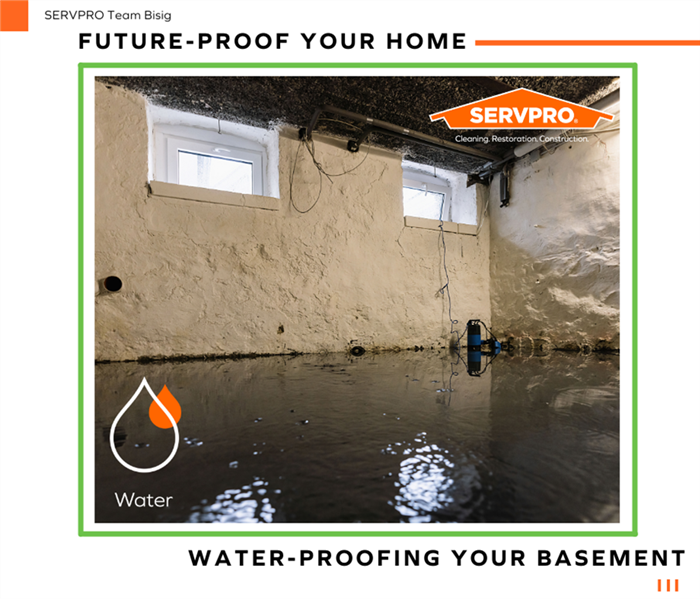 Whether you live in Nashville, Percy Priest, or Hickory Hollow, our water damage restoration team is here to help you 24/7/365
Whether you live in Nashville, Percy Priest, or Hickory Hollow, our water damage restoration team is here to help you 24/7/365
Purchasing a home in Southeast Nashville is a significant milestone and undoubtedly a considerable investment. To ensure your home's longevity and value, taking proactive steps to prevent water damage should be high on your list of priorities. By investing in basement waterproofing and promptly enlisting the help of professional water damage restoration services at the first hint of an issue, you can protect your precious asset from the devastating effects of water.
Preemptive Waterproofing to Safeguard Against Water Damage
Initiating waterproofing measures can save you from future headaches and financial stress. Although there's an upfront cost to consider, the benefits of waterproofing in the long term make it an investment that pays off in spades.
Understanding Home Structures and Their Waterproofing Needs
The diverse range of basement structures in Southeast Nashville homes implies varied waterproofing requirements. Each type, be it a full basement, a partial one, or a crawl space, comes with its unique set of challenges. Full basements provide more usable space but are more prone to water intrusion, while crawl spaces might seem less at risk due to their size, but inadequate protection can result in moisture build-up leading to mold and structural damage.
Choosing the Right Waterproofing Approach
Selecting the best waterproofing method depends on the type of basement your home has and the specific issues it poses. Some prevalent strategies include:
- Interior Sealants: Application of water-resistant sealants on interior walls and floors can ward off minor dampness and condensation. These sealants are often used to treat localized leaks and cracks.
- Interior Water Drainage: This is one of the most effective methods to prevent water accumulation in your basement. It involves creating a channel inside the basement floor along the perimeter, collecting water and directing it to a sump pump system.
- Exterior Waterproofing: This method, also known as "positive side waterproofing," involves applying a waterproof coating or membrane on the outside of the basement wall to prevent water from entering the structure.
- Exterior Drainage System: Similar to interior water drainage, this system manages water at the exterior of the foundation and directs it away from your home.
- Drainage Enhancements: Upgrading your drainage system can prevent water from pooling around your home's foundation. Techniques may involve installing French drains, sump pumps, or regrading your lawn to divert water away from your home.
- Crawl Space Encapsulation: This technique requires the installation of a heavy-duty water vapor barrier in the entire crawl space, protecting it from ground moisture and helping to maintain the structural integrity of your home.
- Sump Pump Installation: A sump pump is a crucial part of many basement drainage systems. It collects water and pumps it away from your home's foundation, keeping your basement dry.
- Crack Injections: This is a technique typically used for poured concrete foundations where cracks have started to appear. The cracks are injected with a material (usually epoxy or polyurethane) that fills the crack from inside to outside, thus waterproofing the area.
- Basement Tanking: This is a method commonly used in Europe, where a waterproof coating or membrane is applied to the interior face of the basement walls to prevent water ingress.
- Cavity Drain Systems: This system includes the creation of a cavity (using studded membranes) on the basement walls and floors. Any water entering through the walls is controlled and diverted to a suitable drainage point.
Remember, the best method for your home will depend on a variety of factors, including the type of foundation, soil conditions, and the specific challenges presented by your home's structure. Always consult a professional for personalized advice.
By waterproofing your basement or crawl space, you offer your home robust protection against persistent dampness that can compromise its structural strength. This step helps you avoid expensive future repairs and increases your property's value, making it a selling point if you ever decide to list your home. Essentially, waterproofing is an investment towards your home's longevity and worth.
Prompt Action and the Importance of Water Damage Restoration
Despite preventative measures, water damage can still strike, often due to unexpected events like severe weather. In such situations, immediate action and the engagement of professional water damage restoration services are crucial. The faster you respond, the less damage is done, and the lower the overall restoration expenses will be.
Our SERVPRO of Southeast Nashville team offers extensive expertise, experience, and state-of-the-art equipment. We’re equipped to tackle visible water damage, but more importantly, we can identify and mitigate hidden issues, such as concealed moisture, mold growth, and structural instability.
The Combined Benefits of Waterproofing and Water Damage Restoration
Waterproofing and water damage restoration are two complementary services that together provide a holistic approach to safeguarding your home's future. While waterproofing forms your first line of defense against water damage, restoration services are there to mend and recuperate your property if damage does occur. Together, they offer a comprehensive solution to protect your home from water's destructive effects.
Investing in your home today through preventative measures like waterproofing and promptly securing reliable water damage restoration services when necessary, will save you time, money, and future distress. Our seasoned professionals at SERVPRO of Southeast Nashville are ready to help your home stand the test of time. Contact us today to learn how we can assist you in protecting your home from potential water damage.
The Fire Damage Restoration Timeline: What to Expect During the Process
4/6/2023 (Permalink)
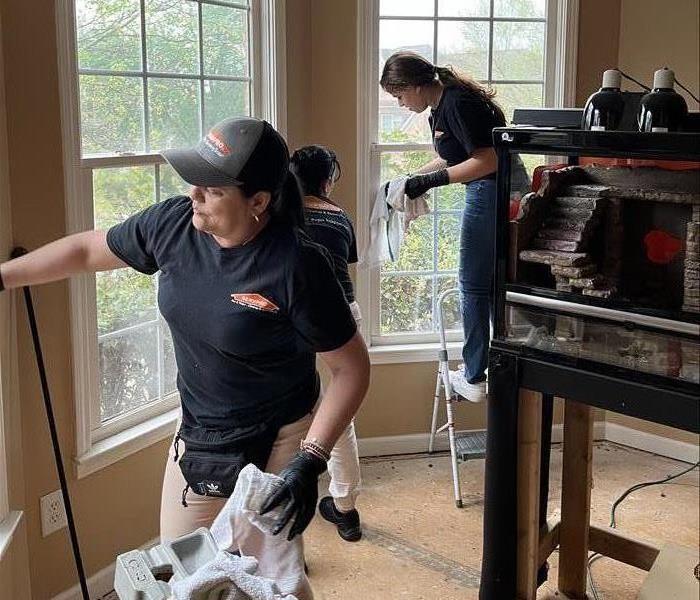 Our SERVPRO Fire Damage Restoration team is here to help you whether you live in Percy Priest, or anywhere else in the Nashville Metropolitan area.
Our SERVPRO Fire Damage Restoration team is here to help you whether you live in Percy Priest, or anywhere else in the Nashville Metropolitan area.
When a fire wreaks havoc on your home or business, it can be an overwhelming experience. After the flames have been extinguished, the fire damage restoration process begins. Understanding the timeline and what to expect during each stage can help alleviate some of the stress and uncertainty surrounding this difficult time. In this article, we will outline the key steps involved in fire damage restoration and provide a general timeline of the process, highlighting the importance of choosing a reputable company like SERVPRO of Southeast Nashville to guide you through the journey.
Initial Assessment and Inspection
The first step in the fire damage restoration process is an initial assessment and inspection of the property. This typically occurs within 24 hours of contacting a professional restoration company. This is also the ideal moment for our team to help you if your property insurance company is involved. During this stage, restoration experts from SERVPRO of Southeast Nashville will visit your property to evaluate the extent of the fire, smoke, and soot damage. This information will help form the basis of a restoration plan, including an estimated timeline, cost for the project.
Securing and Stabilizing the Property
Once the initial assessment is complete, the next step is to secure and stabilize your property. This might involve boarding up windows, covering holes in the roof, or setting up temporary support structures to prevent further damage or collapse. This process helps ensure the safety of both the property owners and the restoration team throughout the remainder of the project.
Water Extraction and Drying
If water was used to extinguish the fire, it's crucial to address any remaining moisture quickly to prevent further damage and mold growth. The water extraction and drying process usually begins within 48 hours of the initial inspection. During this stage, professional restoration technicians from SERVPRO of Southeast Nashville will use specialized equipment, such as industrial-strength dehumidifiers and air movers, to remove excess water and facilitate the drying process.
Cleaning and Soot Removal
Once the property is dry, the cleaning and soot removal process begins. This typically takes place within a few days to a week following the initial inspection, depending on the extent of the damage. Technicians from SERVPRO of Southeast Nashville will meticulously clean all surfaces, remove soot and smoke residue, and deodorize the property using specialized cleaning techniques and equipment.
Restoration and Repairs
The final stage of the fire damage restoration process involves restoring and repairing your property to its pre-fire condition. This can include tasks such as painting, replacing drywall, installing new flooring, or even more extensive reconstruction work. The duration of this phase can vary greatly depending on the extent of the damage and the scope of the repairs needed. However, a professional restoration company like SERVPRO of Southeast Nashville will work diligently to ensure your property is restored as quickly and efficiently as possible.
Conclusion
The fire damage restoration process can be a lengthy and complex journey, but understanding the timeline and what to expect during each stage can help make the experience more manageable. By partnering with a reputable and experienced company like SERVPRO of Southeast Nashville, you can rest assured that your property is in capable hands and will be restored to its former glory in the shortest possible time.
If you find yourself in need of fire damage restoration services, don't hesitate to reach out to SERVPRO of Southeast Nashville. Our team of highly trained professionals is ready to help you navigate the process and provide the expert care your property needs. Contact us today to begin your journey toward a fully restored and revitalized home or business.
The ABCs of Water Damage Restoration: Understanding the Different Types of Water Damage and their Restoration Processes
2/20/2023 (Permalink)
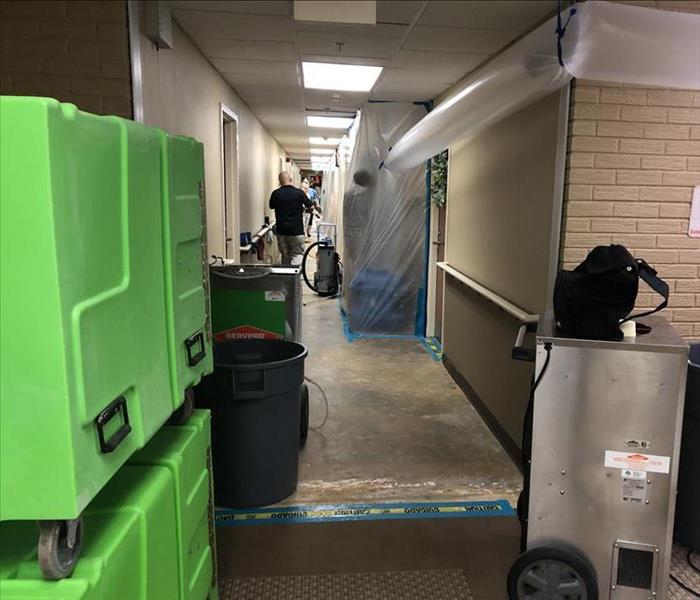 SERVPRO water damage restoration team at work in the hallway of a commercial restoration project in Nashville, TN
SERVPRO water damage restoration team at work in the hallway of a commercial restoration project in Nashville, TN
Water damage can be devastating to a property, regardless of the source. Whether it's a flood, a burst pipe, or a leaky roof, water can cause significant damage to your home or business, leading to costly repairs and potential health risks. Understanding the different types of water damage and their restoration processes can help you better prepare for and respond to water damage events.
In this blog post, we'll break down the three categories of water damage and the restoration processes associated with each.
Category 1 Water Damage: Clean Water
Category 1 water damage is the least severe and easiest to clean up. It refers to water that is clean and free from contaminants, such as water from a burst pipe or rainwater.
Restoration Process: The restoration process for Category 1 water damage typically involves the following steps:
- Water Extraction: The first step in any water damage restoration process is to remove the water. This involves using specialized equipment to extract water from the affected areas.
- Drying: Once the water has been extracted, the drying process begins. This involves using dehumidifiers and air movers to dry out the affected areas and prevent the growth of mold.
- Cleaning: After the area has been dried, cleaning and disinfecting the affected surfaces is necessary to prevent the growth of bacteria and other harmful organisms.
Category 2 Water Damage: Gray Water
Category 2 water damage is more severe than Category 1 and requires more extensive restoration efforts. Gray water is water that contains some level of contaminants, such as water from a dishwasher or washing machine.
Restoration Process: The restoration process for Category 2 water damage is more complex than Category 1, involving the following steps:
- Water Extraction: The first step in the restoration process is to extract the water from the affected areas, using specialized equipment.
- Drying: After the water has been removed, the drying process begins. This step may take longer than in Category 1 water damage, as the water may have seeped into porous materials, such as carpets and upholstery.
- Sanitizing: The next step is to sanitize the affected areas to eliminate bacteria and prevent mold growth. This may involve using specialized products to clean and disinfect surfaces.
- Restoration: The final step in the restoration process is to repair or replace any damaged materials or structures, such as flooring or drywall.
Category 3 Water Damage: Black Water
Category 3 water damage is the most severe and dangerous type of water damage. It involves water that is highly contaminated, such as sewage or floodwater. This type of water damage poses a significant health risk and requires immediate and extensive restoration efforts.
Restoration Process: The restoration process for Category 3 water damage is the most complex and may involve the following steps:
- Water Extraction: The first step in the restoration process is to extract the water from the affected areas, using specialized equipment.
- Disinfecting: After the water has been removed, the area must be disinfected to eliminate harmful bacteria and other organisms.
- Decontamination: If the water has come into contact with porous materials, such as carpeting or drywall, these materials must be removed and replaced to prevent the growth of mold and bacteria.
- Restoration: The final step in the restoration process is to repair or replace any damaged materials or structures, such as flooring or drywall.
Water damage can be a costly and dangerous problem for any property owner. It's important to understand the different types of water damage and the restoration processes involved in each category. Category 1 water damage is the least severe and easiest to clean up, while Category 2 and 3 require more extensive restoration efforts.
No matter the category of water damage, it's crucial to seek professional help from a reputable water damage restoration company, like SERVPRO of Southeast Nashville, to ensure that the restoration process is done efficiently and effectively. Our team of experts is well-equipped to handle any water damage situation, providing 24/7 emergency services and state-of-the-art restoration techniques. Don't hesitate to reach out if you're in need of water damage restoration services.
Tornado Preparedness: Critical Tips to Keep Your Home and Family Safe
5/31/2022 (Permalink)
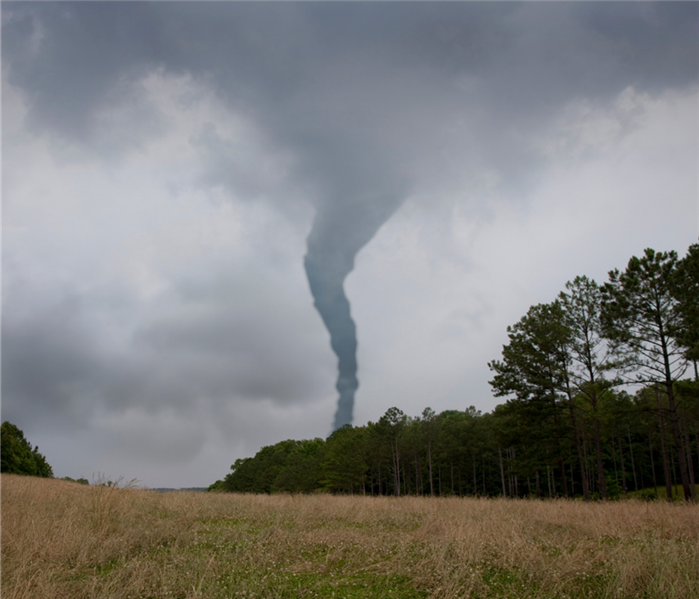 No matter when a tornado strikes, SERVPRO of Southeast Nashville is your local storm damage expert. Call today for fast, immediate help!
No matter when a tornado strikes, SERVPRO of Southeast Nashville is your local storm damage expert. Call today for fast, immediate help!
A tornado can strike at any time, without warning, even in Nashville, TN. That's why it's important to be prepared for a storm before it hits. Yesterday, May 30, 2022, a devastating tornado hit Minnesota, destroying as many as 100 homes. As climate change takes hold, stronger and more unpredictable storms are likely. This is why tornado preparedness is more critical than ever. In this article, we'll discuss a few important tips to prepare your home and family for a tornado before it happens. SERVPRO is always here to help with storm damage cleanup and fast response!Be Aware of the Weather
Be careful of the weather conditions in your area. Tornadoes can be very dangerous and unpredictable, so watch out for any changes in the weather that could indicate one is forming. If you know there will be thunderstorms, keep an eye on local radio and television stations or NOAA radio for further updates. Tornadoes may develop rapidly, as they did in Forada, Minnesota. Some tornadoes strike before there is time for a tornado warning. The following weather indicators indicate that a tornado is approaching:- A large, low, and dark cloud
- A dark or greenish sky
- A loud train-like roar outside
- Hail, especially larger hail
If you notice any of these conditions, take cover immediately.Prepare for Storm Damage in Advance
Preparation is key and can even mean the difference between life and death for your family. That is why, if you live in a tornado-prone area, you should organize a storm-kit with the following items in advance:- A tornado emergency plan including the location and access to a safe shelter for yourself, your family, people with special needs, and your pets
- An emergency kit (including water, non-perishable food, and medication)
- Fresh batteries and a battery-operated TV, radio, or internet-enabled device to listen to the latest emergency weather information
- A list of important information, including telephone numbers and important contacts, important health information, banking information, etc.
Make certain that your children know what a tornado is, when tornadoes occur, and what the various types of watches and warnings are. (Counties will often issue warnings.)SERVPRO is Here to Help
When a storm strikes, the most important thing is to protect the health and safety of your loved ones. Your home is often the first line of defense, and while protecting you, it often takes damage even if its not visible at first.If you or someone you know has suffered storm damage to their home from a tornado, strong thunderstorm, storm-related wind gusts, or other kinds of storm damage, call your local SERVPRO experts today at (615) 731-4222We're Faster to any size disaster!
Spring Storms and Weather Events in the United States | SERVPRO® of Southeast Nashville
5/31/2022 (Permalink)
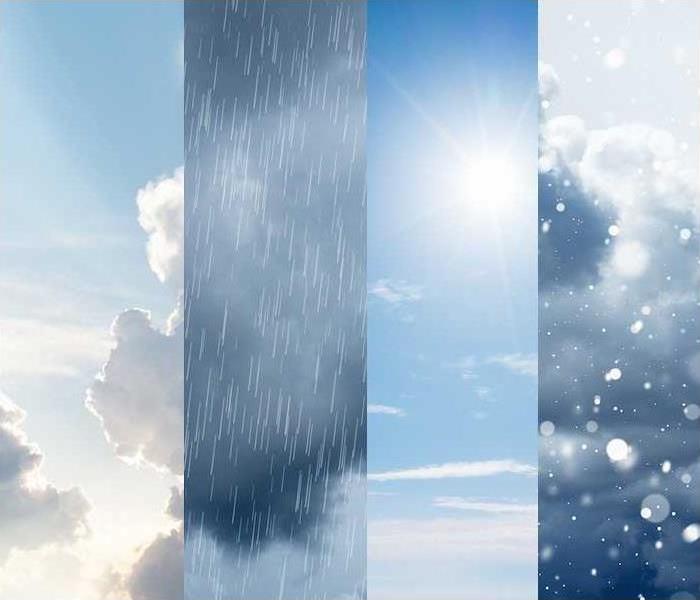 Extreme temperature changes can lead to severe weather. SERVPRO of Southeast Nashville is a click away if you experience any damage.
Extreme temperature changes can lead to severe weather. SERVPRO of Southeast Nashville is a click away if you experience any damage.
Because the United States is one of the world's most significant countries, it has a vast and varied terrain. As a consequence, seasonal weather in the United States isn't uniform—different portions of the country face varying types of weather conditions, which leads to different levels of weather concerns for various locations.
Let's take a look at the weather patterns that can form as spring approaches and warm and cold air masses collide across the country—and what we may learn from them in Tennessee. From December through April, the Pacific Northwest is prone to heavy rain, which might cause flooding and water damage. Snow will continue to build at higher elevations as the season progresses, bringing difficulties of its own owing to melting and runoff. The Upper Midwest and Northeast have the longest winter season, with temperatures remaining below freezing for the majority of it. People can anticipate ice storms, blizzards, and even significant snowfall until late spring or early summer in Maine to Minnesota. Extreme heat waves, on the other hand, will be a major problem in the Southwest and southern West Coast. The possibility of tsunamis produced by tectonic activity in the South Pacific region, including Hawaii, will be high on watch. From Iowa to Texas, the center of the country will need to be on guard for windstorms, derechos and the prospect of wildfires, which might swiftly spread due to strong winds and arid conditions. Tornado Alley is especially vulnerable to tornadoes, with a large part of this region being known as such. Finally, throughout the Southeast, we can anticipate a wide range weather events, ranging from thunderstorms and tornadoes in low-lying regions to early-season hurricanes along the shoreline later in the spring. Late-season snow has hit numerous locations in Middle Tennessee. Extreme weather can happen in any part of the United States. While it varies from state to state, being aware and prepared for severe weather is never a bad idea. Help is only a phone call or an email away if extreme weather causes you property damage from water, fire, or other forces. For local, rapid, professional restoration, contact SERVPRO of Southeast Nashville. We are always Here to Help.




 24/7 Emergency Service
24/7 Emergency Service
